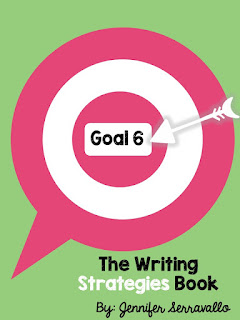The Writing Strategies Book Study: Goal 6- Elaboration
My four year old daughter knows how to ELABORATE. She tells me detailed stories of her school day, her make believe doll stories, and even retells stories I've told her about when I was younger. She includes many details and even interesting language! But elaborating in writing isn't something that comes easily for many of my third grade students.
I am taking part in a collaborative book study of Jennifer Serravallo's The Writing Strategies Book: Your Everything Guide to Developing Skilled Writers, organized by Kelly Malloy. The Writing Strategies Book is divided into goals and each week, another educator blogger is sharing about that goal. You can find previous ones here:
Goal 1 (Composing with Pictures)
Goal 2 (Engagement)
Goal 3 (Generating and Collecting Ideas)
Goal 4 (Focus/Meaning)
Goal 5 (Organization and Structure)
The goal I am sharing this week is Goal 6- Elaboration. Jen says, "Elaboration is the specific information a writer uses to develop her topic. Elaboration includes but is not limited to details, facts, anecdotes, dialogue, inner thinking, setting description, character description, statistics, reasons, information, and direct quotations from interview subjects (208)."
Jen made a point I thought was so true- she said, "What's sometimes challenging for students is that they assume that their reader knows everything they know. Writers then neglect to include enough information so that the reader can also visualize what the writer is visualizing (209)." This makes so much sense when I think of many of my student writers who do not provide details to help the reader understand what is happening. 23 strategies are listed for this goal...wow! I will share 3 of my favorites.
6.5 "Nudge" Paper
This strategy says, "When you feel like a part of your draft needs work, but you're cautious about making changes right on the page, take a strip of scrap paper. Try out your idea on that page. Consider if you want to apply them to your entry or draft (216).
I think this is a low-stress way to push students to try out another approach to a lead, and ending, or any part in the middle! I also like that the writer gets to decide if the change works for him or not.
6.10- Prove It
This strategy asks students to think of their idea or claim and make a list of reasons to support their point. This is perfect for my current unit of study, persuasive speeches! Students write their opinion and list the reasons why that opinion is true. Under each reason, facts or details are listed to support the reason. Once again, the charts and visuals are so helpful here! Boxes and bullets are used to make the point very clear.
6.25- Cracking Open Verbs
"Went" and "Go" are often the culprits- the crime? Dull verbs. Jen explains that writers try to "precisely describe" how a person does something. Students can think about the emotions and feelings behind the actions of a character and replace dull and boring verbs with more "invigorating" ones!
Oops, she did it again! Jennifer Serravallo has once again created a user-friendly, amazingly helpful resource for teachers who want to help their students grow as writers....just like she did for our readers with The Reading Strategies Book. Thank you, Jen, for a book that will be useful for years to come and thank you, Kelly, for coordinating this book study!





Comments
Post a Comment